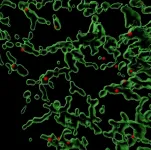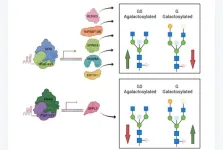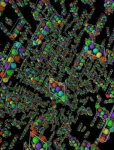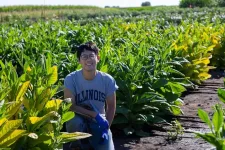(Press-News.org) ANN ARBOR—Because same-sex sexual behavior does not result in offspring, evolutionary biologists have long wondered how the genes associated with this behavior have persisted in the human genome, and whether they will remain in the future.
A new University of Michigan-led study, scheduled for publication Jan. 3 in the journal Science Advances, suggests that part of the explanation—specifically for male bisexuals—has to do with risk-taking behavior.
The U-M researchers analyzed data from more than 450,000 participants of European ancestry in the United Kingdom's Biobank database of genetic and health information. Participants responded to a questionnaire that included the question, "Would you describe yourself as someone who takes risks?"
The U-M analysis revealed that male heterosexuals who carry the genetic variants associated with bisexual behavior, which are known as BSB-associated alleles, father more children than average. Furthermore, men who describe themselves as risk-takers tend to have more children and are more likely to carry BSB-associated alleles.
These and other observations suggest that male BSB-associated alleles confer reproductive benefits because of the shared genetic variants between male bisexual and risk-taking behaviors.
"Our results suggest that male BSB-associated alleles are likely reproductively advantageous, which may explain their past persistence and predict their future maintenance," said U-M evolutionary biologist Jianzhi Zhang, the study's senior author.
"These results also suggest that risk-taking behavior is the underlying cause of BSB-associated alleles' promotion of reproduction in heterosexuals. That is, the reproductive advantage of BSB-associated alleles is a byproduct of the reproductive advantage of risk-taking behavior," said Zhang, the Marshall W. Nirenberg Collegiate Professor in the Department of Ecology and Evolutionary Biology.
The first author of the new study is U-M graduate student Siliang Song.
Risk-taking propensity usually describes a tendency to engage in reward-seeking actions despite the possibility of negative consequences. Although the UK Biobank question on risk-taking did not specify the type of risk, it is likely that self-reported risk-taking includes unprotected sex and promiscuity, which could result in more children, Zhang said.
In their analysis of the genetic underpinnings of same-sex sexual behavior, the U-M researchers looked at both bisexual behavior and exclusive same-sex behavior, which they call eSSB.
When they compared the genetic basis of bisexual behavior to the genetic basis of eSSB, they found them to be significantly different. They found that eSSB-associated genetic variants are correlated with fewer children, which is expected to lead to a gradual decline in their frequency over time.
However, the authors stress that their study looks at the genetic underpinnings of same-sex sexual behavior and not the behaviors themselves, which are affected by both genetic and environmental factors.
In fact, the proportion of UK Biobank participants reporting same-sex sexual behavior has been on the rise in recent decades, likely due to growing societal openness toward it, according to the researchers.
In addition, the authors say their new results "predominantly contribute to the diversity, richness, and better understanding of human sexuality. They are not, in any way, intended to suggest or endorse discrimination on the basis of sexual behavior," they wrote.
The new study is a follow-up to one published in May in Proceedings of the National Academy of Sciences by Song and Zhang. That study also sought to explain the persistence of genetic variants associated with same-sex sexual behavior.
In 2021, Australian biologist Brendan Zietsch and colleagues presented evidence that heterosexuals carrying same-sex-associated alleles have more sexual partners than those not carrying the variants. This could confer a genetic advantage, the authors suggested, because more sexual partners could translate into more children.
In their PNAS study, which also relied on UK Biobank data, Zhang and Song showed that while the mechanism proposed by Zietsch likely worked in pre-modern societies, it is not active today because the widespread use of contraception has decoupled the number of offspring from the number of sexual partners in heterosexuals.
The findings presented in that PNAS paper led Zhang and Song to search for other potential mechanisms for the genetic maintenance of human same-sex behavior. That led to the Science Advances study, which was supported by the U.S. National Institutes of Health.
Study: Genetic variants underlying human bisexual behavior are reproductively advantageous (DOI: 10.1126/sciadv.adj6958)
END
Genetic variants underlying male bisexual behavior, risk-taking linked to more children, study shows
2024-01-03
ELSE PRESS RELEASES FROM THIS DATE:
Shining a light on the hidden damage of mild brain injuries
2024-01-03
Researchers have created a new brain imaging method that allows mild traumatic brain injuries (mTBIs) to be diagnosed, even when existing imaging techniques like magnetic resonance imaging (MRI) don’t show any structural abnormalities. The technique involves loading gadolinium, a standard MRI contrast agent, into hydrogel-based micropatches that are attached to immune cells called macrophages. mTBIs cause inflammation in the brain, which produces signals that attract macrophages to migrate there. Coupling the gadolinium contrast agent to these cells enables MRI to reveal ...
Weill Cornell Medicine receives grant for blood test to diagnose breast cancer
2024-01-03
Weill Cornell Medicine researchers received a $2.4 million grant from the U.S. Department of Defense Breast Cancer Research Program to validate a new blood test for the early detection of breast cancer.
Researchers are evaluating Syantra DX Breast Cancer (Syantra Inc.), an experimental diagnostic test that detects specific biomarkers in blood associated with breast cancer. The test uses an artificial intelligence algorithm to determine whether a patient is positive for cancer as soon as detectable by mammogram or possibly earlier, and before symptoms arise.
“This new liquid biopsy, ...
Using the body’s own cells to treat traumatic brain injury
2024-01-03
Scientists have created a new treatment for traumatic brain injury (TBI) that shrank brain lesions by 56% and significantly reduced local inflammation levels in pigs. The new approach leverages macrophages, a type of white blood cell that can dial inflammation up or down in the body in response to infection and injury. The team created disc-shaped microparticles called “backpacks” containing anti-inflammatory molecules, then attached them directly to the macrophages. These molecules kept the cells in an anti-inflammatory state ...
UW–Madison scientists reveal the inner workings of an essential protein trafficking complex
2024-01-03
MADISON – Like mail carriers who manage to deliver their parcels through snow, rain, heat and gloom, a critical group of mammalian proteins helps cells function properly even under less-than-ideal conditions.
Using state-of-the-art cell imaging and genome editing technology, University of Wisconsin–Madison scientists have begun to unravel how this collection of proteins performs its essential service. The discovery could eventually help researchers better understand and develop new treatments for diseases like cancer, diabetes and those that cause immune dysfunction.
Led by Anjon Audhya, a professor in the Department of Biomolecular Chemistry, the research team sought ...
Mapping of the gene network that regulates glycan clock of ageing
2024-01-03
“[...] we were able to confirm the functional role of three genes (MANBA, TNFRSF13B and EEF1A1) in the IgG galactosylation pathway [...]”
BUFFALO, NY- January 3, 2024 – A new research paper was published in Aging (listed by MEDLINE/PubMed as "Aging (Albany NY)" and "Aging-US" by Web of Science) Volume 15, Issue 24, entitled, “Mapping of the gene network that regulates glycan clock of ageing.”
Glycans are an essential structural component of immunoglobulin G (IgG) that modulate its structure and function. However, regulatory mechanisms behind this complex posttranslational ...
Computational method discovers hundreds of new ceramics for extreme environments
2024-01-03
DURHAM, N.C. – If you have a deep-seated, nagging worry over dropping your phone in molten lava, you’re in luck.
A research team led by materials scientists at Duke University has developed a method for rapidly discovering a new class of materials with heat and electronic tolerances so rugged that they that could enable devices to function at lava-like temperatures above several thousands of degrees Fahrenheit.
Harder than steel and stable in chemically corrosive environments, these materials ...
Community cancer care linked with poorer outcomes for patients with a common head and neck cancer
2024-01-03
FOR IMMEDIATE RELEASE
Care for patients with human papillomavirus (HPV)-related squamous cell cancers of the oropharynx (an area in back of the throat) is shifting toward community cancer centers, but patients treated in this setting may be less likely to survive, according to new research by investigators from the Johns Hopkins Kimmel Cancer Center and its Head and Neck Cancer Center.
The study, published Jan. 3 in the Journal of the National Cancer Institute, raises concerns about the quality of care that patients with this type of head and neck cancer receive outside of academic medical centers. Patients treated ...
Beta blocker used to treat heart problems and other medical concerns could be new treatment for sickle cell cardiomyopathy
2024-01-03
INDIANAPOLIS—A beta blocker typically used to treat heart problems, hemangioma, migraines and anxiety could be a new therapeutic for patients with sickle cell disease. Researchers led by Ankit A. Desai, MD, associate professor of medicine at the Krannert Cardiovascular Research Center (KCVRC) at Indiana University School of Medicine, have been awarded a $3 million grant by the U.S. Department of Defense to evaluate the efficacy of this drug.
Patients with sickle cell disease, a red blood ...
Cleveland Clinic and University of Western Ontario awarded $4.9 million from the Helmsley Charitable Trust to build Crohn’s disease and ileostomy research consortium
2024-01-03
Cleveland Clinic and the University of Western Ontario have been awarded a $4.9 million grant from Helmsley Charitable Trust to build a consortium to develop clinical trial outcome tools for patients with Crohn's disease and permanent ileostomy.
A permanent ileostomy is a surgical procedure to divert stool from the intestine after removing part of or the whole colon. The new Endpoint Development for Ostomy Clinical Trial (EndO-trial) Consortium seeks to develop more effective drugs for patients with Crohn's disease who have undergone ...
Researchers improve seed nitrogen content by reducing plant chlorophyll levels
2024-01-03
Chlorophyll plays a pivotal role in photosynthesis, which is why plants have evolved to have high chlorophyll levels in their leaves. However, making this pigment is expensive because plants invest a significant portion of the available nitrogen in both chlorophyll and the special proteins that bind it. As a result, nitrogen is unavailable for other processes. In a new study, researchers reduced the chlorophyll levels in leaves to see if the plant would invest the nitrogen saved into other process that might improve nutritional quality.
Over the past few decades, researchers ...



